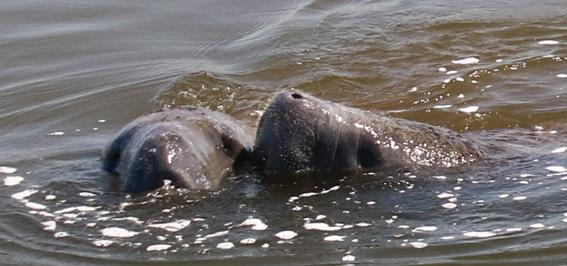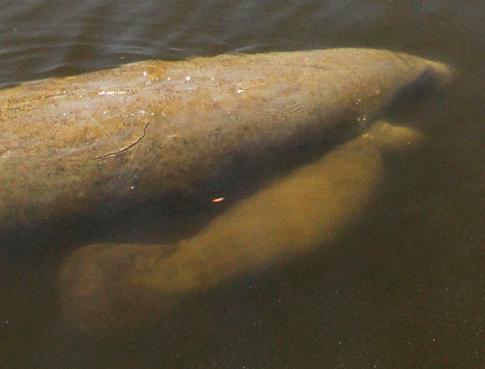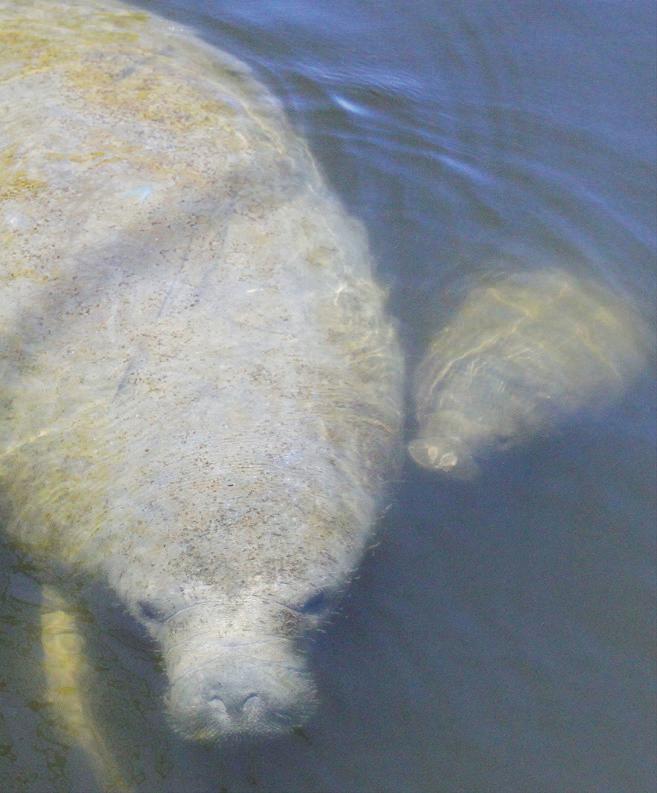
3 minute read
Manatee Facing Starvation
This image and below: manatees socializing at the surface.
All photos provided by GADNR
Advertisement
It’s not known yet if the adult manatee found dead at the mouth of the Altamaha River in April is a harbinger of trouble to come.
But a necropsy of the 1,500-pound animal suggests its demise is connected to the die-off of 761 manatees along Florida’s Atlantic Coast so far this year. DNR senior wildlife biologist Clay George said the Altamaha manatee had a GI tract full of marsh grass, yet its fat stores were severely depleted.
A decline in seagrass – which manatees eat – and an increase in algal blooms, both caused by poor water quality, are seen as leading culprits in Florida's surge of distressed and dying manatees. A second factor is sub-average winter temperatures that bunched animals at manmade warm-water sites, such as power plants, where there wasn’t enough food.
Manatees migrating to Georgia will find an all-they-can-munch buffet of cordgrass and other marsh vegetation. But the fallout from chronic malnutrition and the stress of migration could catch up with some animals. As it likely did with the manatee that died in the Altamaha.
The U.S. and Florida Fish and Wildlife Services have declared an Unusual Mortality Event (UME). The deaths this year are three times higher than average.
“It remains to be seen if we will see an uptick in mortality as more manatees begin arriving,” George said. “Everyone hopes things will improve this summer now that the water has warmed up and manatees can disperse and find food in other locations with better food resources.
The concern is that mortality will resume next winter if the seagrass resources are not able to recover between now and then. We know from satellite tracking data that many of the manatees that migrate to Georgia each summer spend their winters in Brevard County, and neighboring Florida counties, so an unknown (but potentially sizeable) number of our manatees have likely been affected by the UME.”

To read about what the Florida FWC is doing, visit: myfwc.com/research/manatee/rescue-mortality-response/ume/ To learn how the U.S. Geological Survey Wetland and Aquatic Research Center is investigating this UME, visit: bit.ly/usgs_investigatesUME For statistics on this UME visit: bit.ly/manatee_deaths
Boaters can help protect manatees by:
• Looking for manatees before cranking your boat’s motor. • Using caution when navigating in shallow water and along the edge of a marsh. Manatees cannot dive away from boats in these areas. • Heeding “slow speed,” “no wake” and manatee warning signs, especially around docks. • Wearing polarized sunglasses to reduce glare and make it easier to spot manatees below the surface. • Watching for trails of large swirls in the water (called footprints) caused by manatees diving away from the boat.

In muddy or dark water, manatees can be hard to see.

More on Manatees
• West Indian manatees, including the Florida subspecies found in Georgia, are protected under the Endangered Species Act (they are listed as threatened) and Marine Mammal Protection Act, which makes it illegal to harass, hunt, capture or kill any marine mammal. Conviction at the federal level is punishable by fine of up to $50,000 and/or one year in prison. • If you see or photograph a healthy, hurt or dead manatee, call DNR at (800) 2-SAVE-ME (800-272-8363). Note the date, time, location, number of manatees and, if possible, coordinates. • Never feed manatees or give them fresh water. This could teach them to approach docks, putting them at greater risk of a boat strike.
A manatee dining on marsh grass, a primary part of their diets. Take extra care near shorelines, banks and docks, as manatees may be foraging at the water's edge.











